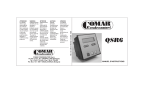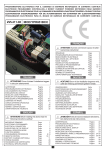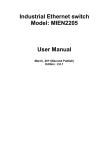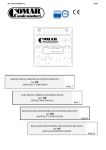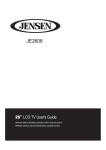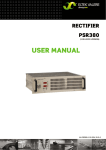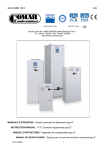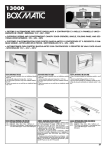Download USER MANUAL - Comar Condensatori
Transcript
WARNING COMAR declines all liability for any damage to people or property caused by unsuitable or incorrect use of its products. Comar reserves The right to change product specifications wiThout prior notice. ATTENTION COMAR décline toute responsabilité pour éventuels dommages à personnes et matériels causés par une utilisation impropre ou par un emploi des produits incorrect. Comar se reserve le droit de modifier sans preavis les caracteristiques tecniques des materiels. ACHTUNG COMAR lehntjede Verantwortung für eventuelle Schäden an Personen oder Sachen infolge von unsachgemäßem Gebrauch der Control ab. Änderungen vorbehalten. ATENCION La COMAR declina toda responsabilidad por eventuales danos a personas o cosas producidos por el uso inadecuado o equivocado de sus productos. Puede ser modificado sin preaviso. COMAR CONDENSATORI S.p.A. Via del Lavoro, 80 - CRESPELLANO (Bologna) Tel. + 39 51 733.383 - Fax + 39 51 733.620 P.O. Box 134 - 40011 ANZOLA EMILIA (Bologna) MU - 03.10.Mmm REV.NO - 05-2000 - 1000 ATTENZIONE La COMAR declina ogni responsabilità per eventuali danni a persone o cose originati da uso improprio o da errato impiego dei propri prodotti. Soggetto a modifiche senza preavviso. USER MANUAL QSR6 User manual page 21 Index 1 1.1 1.2 1.3 1.4 1.5 2 2.1 2.2 2.3 2.4 2.5 3 3.1 3.2 3.3 3.4 3.5 4 4.1 Instruction Introduction Operator safety Instructions for proper installation Cleaning Warranty General Unit description Mechanical fixing Working situation Power of controlled banks Number of steps Technical features General features Reference standard Mechanical dimensions Pinout diagram How to choose the C.T. Functions Powering on p.22 p.22 p.23 p.23 p.23 p.24 p.24 p.24 p.24 p.25 p.25 p.25 p.26 p.26 p.27 p.28 p.29 p.30 p.32 p.32 21 4.2 4.3 4.4 4.5 4.6 4.7 5 5.1 5.2 6 Key functions Automatic Manual Manual insertion of the banks Alarms Alarm memory Set-up C/K setting P.F. setting Working troubles and solution p.32 p.33 p.34 p.35 p.36 p.37 p.38 p.38 p.39 p.40 1 Instruction 1.1 Introduction Before connecting the regulator to the mains, read the instructions in this handbook, they provide important indications about the safety, use and maintenance. Take carefully this handbook for any information. This regulator has been manufactured and tested in accordance with international standard, it leaves the factory in perfect safety conditions. In order to mantain these condition and to ensure safe operation, the user must comply with the instructions and remarks given in this manual. After removing the packaging check that the regulator has not been damaged during transport. In case of doubt, do not attempt to fix or use the regulator. If the equipment has falled down or has been violently shaken during transport, it could suffer internal damages which may be dangerous. After checking that regulator cannot be safely used, it must be placed out of order and not used before checking of experienced personnel. Causes that bring to put the regulator out of order are the presence of external damages, missed functioning, unproper stocking or transport conditions. Technical Assistance on the regulator must be performed exclusively by COMAR personnel. 22 1.2 Operator safety Before to perform any maintenance, the regulator must be disconnected from any power supply source, wait 5 minutes before start any action. During maintenance it is necessary to follow standard safety procedures. Do not touch any printed circuit board for any reason. This regulator will be assigned only to the use for which it has been specifically made. Each other use has to be considered improper and therefore dangerous. 1.3 Instruction for proper installation Before connect the equipment, check the data plate: this has to be in conformity with the electrical network (the plate is located on the back of the P.F. Regulator). The regulator is not provided with protection fuse on the power supply, it has to be protected externally by the user. Being the regulator designed for permanent operation (CEI EN 61010-1), the supply have to be interrupted by automatic switch, which has to be placed close the regulator for easy intervention. For the correct functioning of the equipment, the limit of voltage, current and temperature, imposed by the CEI and IEC standard must never be exceeded. The equipment has to be protected from athmospheric conditions. 1.4 Cleaning After disconnecting the instrument from the power supply, clean the external surface of the plastic box using a soft cloth dipped in water only. Never use abrasive or solvent. Never wet the connection terminals. 23 1.5 Warranty Comar Condensatori S.p.A. guarantees its own products for twelve months from purchase date. The warranty covers the faults of materials and manufacture and it has to be understand for goods ex-works. Before the equipment works, all instructions, present on this handbook, have to be meticulously followed. Breakdowns caused from improper use and/or not conformity to enclosed instructions and faults caused from tampering by unqualified technicians aren’t covered. The misuse of any of the previous points will erode the right of warranty. 2 General 2.1 Unit description QSR is an automatic microprocessor regulator which operates the switching on and off of the capacitors steps which are necessary to reach and to maintain the required power factor value. The QSR operate an RMS measure which allows correct operation and display even in presence of harmonics. The central microprocessor unit controls all settings and parameters. 2.2 Mechanical fixing The regulator should be mounted in a cutout (drilling template 92x92mm.) using the special fixings supplied. 24 2.3 Worning situation The regulator works according to binary logic sequence; the switching on and off of capacitors banks always start from the first bank. 2.4 Power of controlled banks For correct operation of the automatic bank, the power ratio per bank should be: a. equal to each other (1-1-1-1-1-1-1-1) b. double of the previous bank (1-2-4-8-16-32) c. equal or double of the previous bank (1-1-2-2-4-4) 2.5 Number of steps Is determined by the power combination which has been capacitors bank: Examples: 6 banks in the sequence 1-1-1-1-1-1 6 banks in the sequence 1-1-2-4-4-4 6 banks in the sequence 1-2-4-8-16-32 used on single make 6 steps make 16 steps make 63 steps Note. A too high number of steps as a too high power of first step , produce an high number of switching operation that reduce the life of the equipment. When the first step is too high in power hunting may occur which again would produce excessive wear and reduced life of the components. Normally 8-16 regulating steps is the best solution to adopt 25 3 Technical features 3.1 General features Rated supply voltage Rated consumption Rated supply current Current circuit consumption Rated frequency Controlled banks Output relays Max current relays common Switching steps delay Alarm delay P.F. setting Operating range Digital monitoring Measurement monitoring Accuracy Multivoltage 380÷415V a.c. ± 10% 400V -10% / +5% continuous operation 3 VA By means of CT secondary side st 5A max., 1 class - 5VA (Imin. = 500mA) 2VA 50Hz or 60Hz autoset 6 5A 250 Va.c. resistive load 5A at 40°C resistive load 25" (5" on request) 10"÷ 1" 0,90 lag ÷ 0,90 lead Power Factor 0,20 ÷1,00 lag / lead Alphanumeric 2x16 characters LCD display P.F. 0,20÷1,00 lag / lead On the P.F. regulation range ± 2 f.s. at +25°C and 2,5A. 26 Temperature accuracy Connection Mechanical dimensions Cut out dimension Mechanical fixing Plastic case Weight Protection degree Working temperature Storage temperature Relative humidity Type of service +/- 10% With terminal fixing screws, cable of 2,5 2 mm c.s.a. 96x96 mm FRONT (according to DIN43700) 60mm DEPTH 92x92 mm (tolerance -0mm /+ 1mm). With the special accessories supplied included Insulating self-extinguishing material 0,5 Kg IP 54 front panel - IP20 terminal board 0°C to + 50°C -20°C to +60°C Max. 90% at 20°C noncondensing Indoor service, no dusty condition. Do not place directly under sun light. 3.2 Reference standard Safety EMC Protection degree IEC 1010 440V CAT III EN50082-1, EN50082-2, EN50011, EN55022 CEI-EN 605.29 27 Mechanical dimensions 96mm 60mm 38,2mm 18,3mm 3,5mm 91mm 60mm 38,2mm 3,5mm 18,3mm 4" Setup 28 91mm 96mm 68mm Power Factor Regulator Made in Europe 3.3 3.4 Pinout diagram Carichi Loads Charges Verbraucher Cargas CT../5 220V L 0V 1A T1 T2 T3 T4 T5 T6 C1....6 X1X2 1 2 3 4 5 6 C Allarme Alarm Alarme Störung Alarma A A V 29 V Max 4A K 3.5 How to choose the CURRENT TRANSFORMER (C.T.) Use a Current Transformer (C.T.) with 5A at secondary circuit and primary equal or slightly higher than the maximum absorbed by the loads. The C.T. must be chosen in such a way to obtain a good current signal in the secondary circuit. Current values between 0.5 and 5Amps are suitable to obtain good working conditions of the regulator. The C.T. must be good quality (first class) and with power equal or higher to 5VA. If the C.T. has been mounted far from the equipment, it needs to add the normal demanded the power consumed from2the cables of connection (normaly 0.2VA per meter of bifilar lines with 2.5mm section) and the power dissipated by others possible tools connected in the circuit. The equations, used to calculate the real losses, are the sequents: R = 2 x x L/S2 (Ω) Total resistance of amperometric circuit P=(R+0.08) x I (VA) Losses of amperometrical circuit ‘ ’ is the electrical resistivity ( 0.018 for the copper ) ‘L’ is the length of amperometric circuit (mt) ‘S’ is the across section of cables at the secondary of TA ‘I’’ is Imax. at the secondary of C.T. ‘0.08’ are the internal resistance of P.F. regulator When single-phase inductive loads are connected (unbalanced three-phase system), place C.T. on the phase where Power Factor is lower and/or where higher current value is absorbed. 2 The cables at the secondary of C.T. have to be of 2,5mm section. The C.T. connection must not to be protected with fuses or interruped by switch. 30 The C.T. has to be connected to the line, upstream the load and the P.F. Regulator: the C.T., can then measure the current demanded by the load, inductive and capacitive. Possible capacitors for fixed P.F.Regulation will be mounted downstream of the C.T., as they aren’t used and dimensioned for the P.F. Regulation of transformers that feed the load. It’s important to check that the phase, where the C.T. is connected, is the same that will be connected to terminals of the main switch, inside the equipment, signed with the letter “L1”. Before doing any work on the C.T. circuit, be sure that the C.T. is shortcircuited, otherwise dangerous voltages can rise, add bringing to breakdown the C.T. P.F. correcting two or more lines (transformers in parallel), you need to use two or more C.T (.../5) of which the secondary circuits will be supplied a add transformer with 5Amps at secondary: connect the current transformers at the same phase. If two or more C.T. ‘s are used with an additional transformer, the value of the primary current is the sum of each C.T. Example: n°3 C.T. ‘s 500/5 = n°1 C.T. 1500/5. Connecting two or more cables (for load and P.F.Regulator) on the same terminal - phase “L1” - from the general main switch, It needs to pass through the hole of the C.T. all the derived cables. Note. QSR regulators are able to detect automatically the current phasing of the CT. It is not necessary to ensure correct polarity connections as with other Power Factor Regulators. 31 4 P.F. Value “+” P.F. Lag “-” P.F. Lead Functions 4.1 Powering on When power is switched on, an internal self test routine has been performed. The display shows the installed s/w release. Banks disconnection CAP Spinning when working Banks +0,93 PF/ connenction 123--- Output ON 4.2 IND Output OFF Key function Power Factor Regulator enable change from The key “Automatic” to “Manual” (light is on). When pressed for 4 seconds it enable to enter the set-up page and confirm setting SELF TEST - v1.9 used in “Manual” Keys enable switch-on and off the output. Used in “SET-UP” enable setting of the value. Used in “Automatic” enable visualization and reset of “Alarm After start-up process, the regulator is memory”. working in ”Automatic” operation. Made in Europe 4" Setup 32 4.3 Automatic Power Factor Regulator Power Factor Regulator +0,93 PF/ 12345- IND +0,97 PF/ ---45- 4" Setup Made in Europe Made in Europe 4" Setup Fig. 1 Fig. 3 Power Factor Regulator -0,99 PF/ CAP --345- Made in Europe 4" Setup Fig.1: inductive loads connected (motors, transformers, decharge lamps, etc.). “IND” indication on and regulator that inserts the required outputs. Fig. 2: capacitive loads connected. “CAP” indication on and regulator that disconnects the exceeding outputs. Fig. 3: P.F. value setted is achieved when Cap and IND indications are off. Output are not changing. Fig. 2 33 4.4 Manual Power Factor Regulator Power Factor Regulator +0,93 PF/ MANUAL 123--- -0,99 PF/ MANUAL CAP --3456 Fig.1 The key is lit (on) Made in Europe 4" Setup Made in Europe 4" Setup Fig.3 Output switch off Power Factor Regulator +0,99 PF/ MANUAL 123456 IND Manual working visualize balanced load (IND and CAP indication off). Switch on/off are made only after the proper response time (25 seconds standard). Made in Europe 4" Setup Fig.2 Output insertion (switch on) 34 Manual insertion of the banks Power Factor Regulator Power Factor Regulator +0,93 PF/ MANUAL 1----- +0,93 PF/ MANUAL ------ 4" Setup Made in Europe 4" Setup Fig.1 Bank insertion Fig.3 Reset memory In Automatic operation the “stored” output are always on. The remaining output are working in Automatic, the stored output can be disconnected exclusively when operation shows in fig.3 occurs (key on, key pressed) or switching off the power supply Power Factor Regulator +0,93 PF/ MANUAL 1----Blinking Made in Europe 4" Setup Fig.2 Entering memory Made in Europe 4.5 35 4.6 Alarms The QSR has a normally closed NC alarm contact (rated 5 A 250 V resistive load). It will be possible to give an external alarm signal. This contact is signed with X1 and X2 in the base of the regulator. When alarm condition disappears, the regulator will reset itself automatically. Reference Condition Display indications No supply voltage V=0 Low P.F. value in the network PF = IND for 15 minuts 0,35 PF/ ALARM 123456 Low voltage V < 340Vac RMS for 10 seconds High voltage V > 450Vac RMS for 10 seconds Zero Current A<50mA RMS for 10 seconds 36 Alarm relay X1 X2 X1 X2 Blinking ALARM 0,95 PF/ MIN V 123--- X1 X2 Quick switch off for all outputs Blinking ALARM 0,95 PF/ MAX V ------ X1 X2 Quick switch off for all outputs Blinking X1 ALARM -,-- PF/ A = 0 ------ X2 Quick switch off for all outputs Blinking Condition Display indication X1 X2 Low current A<350mA RMS for 10 seconds ALARM 0,35 PF/ MIN A 123--Bliking ALARM 0,95 PF/ MAX A 123--- X1 X2 Hight current A>5,5A RMS for 10 seconds PF< ± 0,20 for 10 seconds Bliking ALARM -,-- PF/ CAP ------ X1 X2 Leading P.F. value Bliking ALARM 0,95 PF/ TEMP ------ X1 X2 X1 X2 Reference T°>50°C Hight temperature for 10 seconds Hysteresis level 5°C No alarm Standard operation 4.7 Bliking 0,95 PF/ 123--- Alarm relay Alarm memory To visualize last alarm press To erase memory press at the same time MEMORY = MAX V 123--- MEMORY = VOID 123--- A dot indicates an alarm message stored in memory 37 Inhibit output insertion Quick switch off for all outputs Quick switch off for all outputs 5 Set-up The suggested value to set is given on the table. 5.1 C/K setting Use the selection. or buttons to change the Power Factor Regulator T.A. - C.T. 30/5 50/5 60/5 80/5 100/5 150/5 200/5 250/5 300/5 400/5 500/5 600/5 800/5 1000/5 1200/5 1500/ 2000/5 2500/5 3000/5 4000/5 Made in Europe 4" Setup Puss 4 seconds for aut. functioning Power Factor Regulator 3 C/K Power 1st bank (kvar) C/K +0,93 PF/ MANUAL 123--- SETUP +0,97 PF 5 5 3 3 3 3 2 2 2 2 2 1 1 1 1 1 1 1 1 1 1 6 5 4 4 3 3 3 2 2 2 2 2 1 1 1 1 1 1 1 1 1 10 12,5 20 5 5 5 5 5 3 4 5 3 3 5 3 3 3 3 3 3 2 3 3 2 2 3 2 2 3 2 2 2 2 2 2 1 2 2 1 1 2 1 1 2 1 1 1 1 1 1 1 1 1 1 1 1 25 5 4 3 3 3 3 3 2 2 2 2 1 1 1 1 40 5 5 4 3 3 3 3 3 2 2 2 2 2 1 50 5 5 4 3 3 3 3 3 2 2 2 2 2 When the CT secondary current signal is lower than 2 amps, the C/K value should be increased by 0,1. Blinking When using the regulator on 220Vac networks the C/K values should be doubled. 4" Setup Made in Europe “-” means installation of C.T. with primary value too small. 38 5.2 P.F. setting After setting the C/K value or buttons to change Use the the selection. A P.F. of 0,95 is recommended. Power Factor Regulator 3 C/K SETUP +0,97 PF button, the C/K By pressing the and P.F. values which have been selected will be saved and the regulator works in “Automatic” condition. Blinking Made in Europe 4" Setup Press the “Manual” key Power Factor Regulator 3 C/K SETUP +0,97 PF Blinking Made in Europe 4" Setup 39 6 Working tuonbles and solution. TROUBLE Soluzione All banks on with a low The CT is connected upstream the load but not of capacitors. inductive load on the network Connect the CT as shown in the connection diagram ( § 3.4). a) The C/K value is not correct. Continous switching on and Check in the table "C/K VALUES" for the right value ( § 5.1). off of first bank (hunting b) The power of the first bank is too high for the selected PF requirements. phenomena) Reduce the first bank power according to paragraphs 2.4 and 2.5. Increase the selected PF value ( § 5.2). Displayed PF values not CT installed in the wrong phase: connect to phase L1 ( § 3.4). correct a) Possible stand-by condition: at least one capacitor bank on. Check the PF value of the network on the display. IND and CAP leds off b) Possible MANUAL working condition: choose the AUTOMATIC operation. IND led ON and no insertion of capacitor banks Minimun current alarm. Current lower than 500mA (see § 4.6). CAP led is ON without capacitor banks working CT installed in the wrong phase: connect to phase L1 (see § 3.4). a) Alarm condition of least one value: see chapter (§ 4.6). b) Check supply voltage is correct. a) Check if supply voltage is present. Display off, regulator not working b) Check if supply voltage is equal to the rated voltage of the regulator. Blinking display Display on, banks inserted signalling, but capacitors not working a) Check if supply voltage is equal to the rated voltage of the regulator. b) Check the “0Vac” connection on contactors. c) Check if “220Vac” has been connected on "C" terminal. d) Check contactor functioning. Displayed “ ALARM CAP” on a) Possible capacitive load condition. b) CT installed in the wrong phase: connect to phase L1 (§ 4.6). display c) P.F. lower than 0,20 IND or CAP. a) Zero current signal: check the C.T. and its connection and ensure the minimum secondary current level is least 10mAmps (§ 3.4). Displayed “-.--” on display b) C.T. connected on the supply cable of the PFC equipment. Connect according the connection diagram ( § 3.4). IF PROBLEMS PERSIST AFTER ALL ABOVE MENTIONED SOLUTIONS SWITCH OFF THE REGULATOR FOR AT LEAST 20 SECS AND THEN SWITCH ON AGAIN. IF THE PROBLEM IS STILL PRESENT PLEASE CALL OUR TECHNICAL DEPARTMENT. 40






















